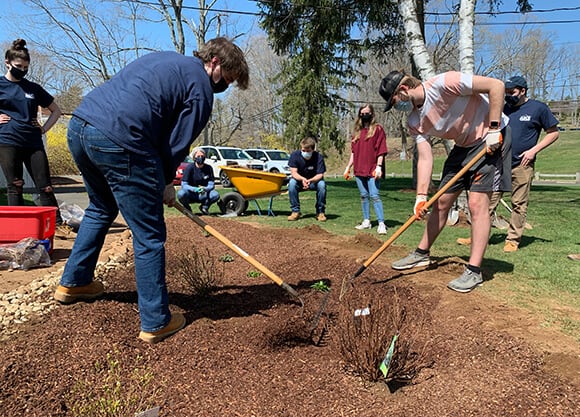
University's new rain garden to benefit wildlife for miles around
April 12, 2021

April 12, 2021

Students, faculty and staff from the School of Engineering, College of Arts and Sciences, and Albert Schweitzer Institute rolled up their sleeves to install a rain garden and a berm to help absorb water runoff before it reaches the Mill River and storm drains.
“This is the realization of a dream I had when I started as executive director of the Albert Schweitzer Institute more than three years ago,” said Sean Duffy, who also served as the co-chair of the sustainability planning committee. “Quinnipiac is a very special place in that it has always supported individuals pursuing interests they are passionate about.”
The concept of the rain garden was born in the mind of Michael Ciacciarella ’21, a civil engineering major and president of the campus’ chapter of the American Society of Civil Engineers.
“Last year, I designed this rain garden in an ecological engineering class,” he said. “We designed it in this spot, with hopes of actually being able to build it. It’s really cool to see something I designed in class come together in real life.”
Duffy, who also serves as a professor of political science, has been at the university for 23 years. He hand-picked 10 native plants that do well in both wet and dry conditions for the 170-square-foot garden. In the Quinnipiac spirit, they are expected to bloom gold, blue and white throughout the year.
Besides the local effect of this garden on the Mill River watershed, rain gardens more generally can play a role in building climate resilience in our region.
“With climate change, our region will get many more heavy rainfall events and so we will need to figure out what to do with the water before it goes into the storm drains and overwhelms the system,” he said. “If we overwhelm the sewers with rainwater, that’s going to overwhelm sewage treatment facilities and all that water will get flushed out into the Sound. If we can hold the water here without having it run into the sewage system, it actually will help us adjust for what is coming.”
Through Duffy’s leadership, a bike rack was installed at the institute as well as compost systems. He also lives what he preaches, with a honey bee colony at his home.
Kimberly DiGiovanni, assistant teaching professor of civil engineering, said the rain garden was carefully designed to capture 1 inch of rainfall from the roof and surrounding areas of the building – because 90% of storms in the area produce 1 inch of rain or less.
“This will capture many of the storms that will happen,” she said. “What is particularly effective about capturing that first bit of rainfall is that is the water that will take anything that has accumulated on surfaces, like oil, grease, fertilizer and bacteria from bird droppings. Instead of going into the Mill River, the water will now be captured in this garden.”
The native plants will then get to work, she said.
“The plants function to capture the rainfall, and then the water will evaporate and transpire,” she said. “They play a really important role in taking up water and releasing it to the atmosphere to restore the green infrastructure to prepare for the next rain event.”
The positive impact of the rain garden will be felt for miles, explained Courtney McGinnis, professor of biology.
“Keeping the pollutants out of the water will benefit the animals and organisms that are right here, as well as downstream — which is considerable since we are pretty upstream on this river,” she said.
Sarah Lawson, assistant professor of biology, has begun researching the pollinators that frequent the Albert Schweitzer property, as well as broader university and neighboring Sleeping Giant State Park to better understand which plants will be beneficial food sources for native pollinators.
“One of every three bites of food we take is brought to us by a pollinator,” she explained.
She said she has a special interest in the more than 300 native bee species in the state — many of which are only a few centimeters long.
Chuck Saia ’91, MBA ‘93, a member of the university’s board of trustees, who funded part of the project in partnership with the Albert Schweitzer Institute through the sales of his book, “You Got This Kid: Words of Advice for Young Leaders.”
“It feels incredible getting to see so many people come out today,” he said. “One of the reasons I created the foundation and chose Quinnipiac to receive the funds is because I knew the university has a passion for environmental sustainability and a commitment to philanthropic initiatives in the world. To bring together this foundation, the university, the Mill River Watershed Association and our students is so wonderful.”
He said sales of his book will help to continue to fund university projects focusing on sustainability as well as lupus research.
“The sustainability strategy at Quinnipiac is better than anything else I’ve ever seen,” he said. “It’s centered around live, learn, lead. When you see this project today, we are creating a rain garden. The university is living better. We are learning because students are learning how to take care of our environment, and we’re leading an effort to protect the Mill River Watershed, which is a pristine place for our surrounding communities. It encompasses all three elements of our sustainability strategy so well.”
Quinnipiac Today is your source for what's happening throughout #BobcatNation. Sign up for our weekly email newsletter to be among the first to know about news, events and members of our Bobcat family who are making a positive difference in our world.
Sign Up Now